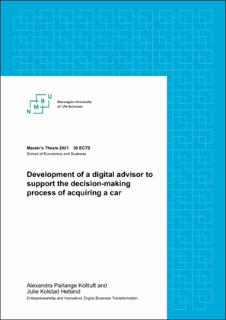| dc.contributor.advisor | Lekang, Odd Ivar | |
| dc.contributor.advisor | Omberg, Kristian | |
| dc.contributor.author | Hetland, Julie Kolstad | |
| dc.contributor.author | Kolltuft, Alexandra Parlange | |
| dc.coverage.spatial | Norway, Oslo | en_US |
| dc.date.accessioned | 2021-07-08T13:09:30Z | |
| dc.date.available | 2021-07-08T13:09:30Z | |
| dc.date.issued | 2021 | |
| dc.identifier.uri | https://hdl.handle.net/11250/2763952 | |
| dc.description.abstract | This thesis explores how consumers behave in the process of acquiring a car and aspires to solve the main challenge that consumers are facing in the decision-making process. The mobility landscape is rapidly evolving and offering consumers more choices than ever before in meeting their transportation needs. The rise of sharing economy and the development of new technologies has facilitated the entrance of new business models and thereby new car ownership types. With the increased use of internet as an information source, much documentation is at the consumer’s disposal. Still, the number of alternatives may lead to confusion, stress and sub-optimal decision-making.
The goal of the thesis is to develop a digital advisor that would provide the end-user with unbiased decision support for acquiring a private car. To achieve the described goal, the study was designed to collect data and test concepts through four phases, in line with design thinking. A theoretical review of the trends in the mobility market, environmental drivers, sharing economy, and the psychology of the decision-making processes was conducted to form the framework. The first phase of the thesis explored the car loan application process through testing current solutions and interviewing consumers. The results showed the car loan application process was not considered problematic for consumers, and that the main challenge was to search, navigate and evaluate information and thereby deciding on an ownership type. The second phase explored the consumers’ information search and decision-making process through interviews. This resulted in a simple prototype for a digital advisor that could solve the identified challenges in the process. The prototype was tested in the third phase, and the content of the digital advisor was defined together with consumers. The fourth and last phase resulted in a definition of the characteristics of each ownership type based on data collection through a survey. | en_US |
| dc.description.abstract | Denne masteroppgaven utforsker hvordan forbrukere oppfører seg i prosessen med å anskaffe en bil og ønsker å løse hovedutfordringen som forbrukerne står overfor i beslutningsprosessen. Mobilitetslandskapet er i rask utvikling og gir forbrukerne mange valgmuligheter for å dekke behovet for transport. Utviklingen av ny teknologi har bidratt til en vekst i delingsøkonomien, noe som har resultert i at nye forretningsmodeller har blitt til og tilført nye typer bilhold i markedet. Med den økte bruken av internett som informasjonskilde har forbrukeren tilgang på mye dokumentasjon. Derimot kan antallet alternativer føre til forvirring, stress og et suboptimalt beslutningsgrunnlag.
Målet med oppgaven er å utvikle en digital rådgiver som vil gi sluttbrukeren upartisk beslutningsstøtte for å anskaffe bil. For å oppnå det beskrevne målet ble data samlet og konsepter testet gjennom fire faser, i tråd med Design thinking. En teoretisk gjennomgang av trendene i mobilitetsmarkedet, miljødrivere, delingsøkonomi og psykologien i beslutningsprosesser ble gjennomført for å danne rammeverket. Den første fasen av oppgaven utforsket søknadsprosessen for billån gjennom å teste nåværende løsninger og intervjue forbrukere. Resultatene viste at søknadsprosessen for billån ikke ble ansett som problematisk for forbrukerne, og at hovedutfordringen var å søke, navigere og evaluere informasjon og derved bestemme seg for typen bilhold. Den andre fasen utforsket forbrukernes informasjonssøk og beslutningsprosess gjennom intervjuer. Dette resulterte i en enkel prototype for en digital rådgiver som kunne løse de identifiserte utfordringene i prosessen. Prototypen ble testet i tredje fase, og innholdet i den digitale rådgiveren ble definert sammen med forbrukerne. Den fjerde og siste fasen resulterte i en definisjon av egenskapene til hver type bilhold, basert på datainnsamling gjennom en undersøkelse.This resulted in a simple prototype for a digital advisor that could solve the identified challenges in the process. The prototype was tested in the third phase, and the content of the digital advisor was defined together with consumers. The fourth and last phase resulted in a definition of the characteristics of each ownership type based on data collection through a survey. | en_US |
| dc.language.iso | eng | en_US |
| dc.publisher | Norwegian University of Life Sciences, Ås | en_US |
| dc.rights | Attribution-NonCommercial-NoDerivatives 4.0 Internasjonal | * |
| dc.rights.uri | http://creativecommons.org/licenses/by-nc-nd/4.0/deed.no | * |
| dc.subject | Mobility | en_US |
| dc.subject | Sharing economy | en_US |
| dc.subject | Car acquisition | en_US |
| dc.subject | Developement | en_US |
| dc.subject | Digital advising | en_US |
| dc.title | Development of a digital advisor to support the decision-making process of acquiring a car | en_US |
| dc.type | Master thesis | en_US |
| dc.description.localcode | M-EI | en_US |

